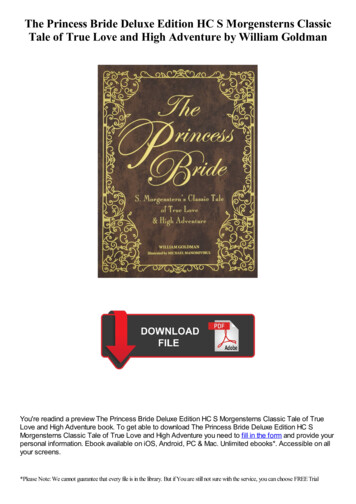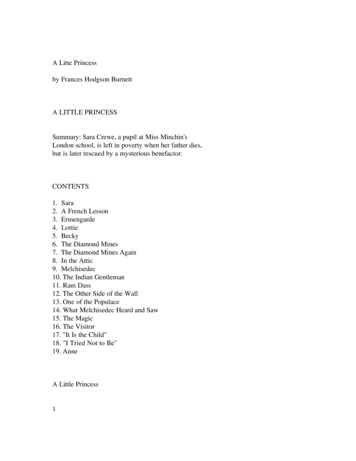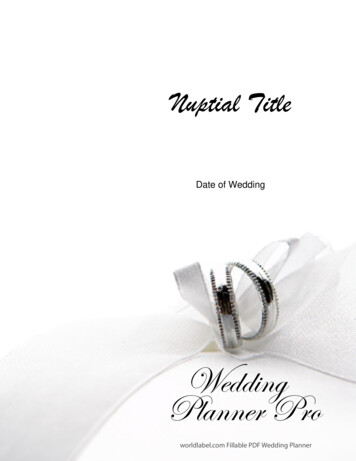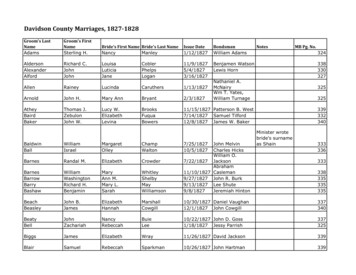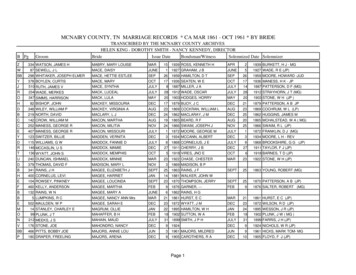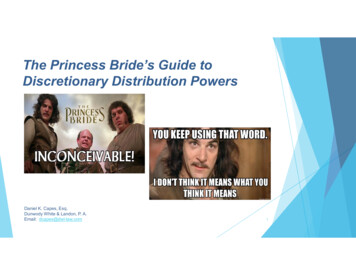
Transcription
The Princess Bride’s Guide toDiscretionary Distribution PowersDaniel K. Capes, Esq.Dunwody White & Landon, P. A.Email: dcapes@dwl-law.com1
Discretionary Distribution ProvisionsHave ConsequencesTrustees are routinely given discretionary distribution powers over a trust’sincome and/or principal.The phrasing and scope of discretionary distribution powers, and relatedprovisions, can have important tax and non-tax consequences to thebeneficiaries and to the trustee.2
Beneficiary TrusteeAlways remember that if a beneficiary can remove trustees, and appointsuccessor trustees who are related or subordinate to that beneficiary, thebeneficiary is treated as holding all of the powers of the trustee. See Estate ofWall v. Commissioner, 101 T.C. 300 (1993); Estate of Vak v. Commissioner, 973F.2d 1409 (8th Cir. 1992), rev'g T.C. Memo 1991- 503; and Rev. Rul. 95-58.The same concept should apply if a beneficiary can remove and appointsuccessor trust protectors, investment advisors, and the like under the trustinstrument.References in this outline to an “independent trustee” mean a trustee who willbe treated as not being related or subordinate to the relevant beneficiary and/orwhose powers as trustee are not attributed to the beneficiary due to anyremoval and appointment powers granted to the beneficiary.3
Ascertainable and Non AscertainableDistribution StandardsWe often think of discretionary distribution powers from a tax perspective –Ascertainable Standards: Those powers that a beneficiary can hold without adverseestate/gift/GST/income tax consequences.Non Ascertainable Standards: Those powers that the beneficiary cannot hold withoutpotentially adverse tax consequences.Understanding the distinctions between those two standards is important toavoid adverse tax (and perhaps creditor) consequences if a beneficiary will be atrustee or have the power to remove trustees and appoint related orsubordinate successor trustees.4
Pros/Cons of Ascertainable StandardsAscertainable standardsBenefitsAvoids estate/gift tax inclusion for a beneficiary trusteeMay help avoid creditor exposure for a beneficiary trusteeClearer guidance for the trustee and the beneficiary (maybe?)Less exposure for drafting mistakesDrawbacksMay be less flexible than a non ascertainable standardMay provide greater creditor rights5
Pros/Cons of Non AscertainableStandardsNon ascertainable standardsBenefitsUsually greater flexibility than ascertainable standardsDrawbacksRequires third party trusteeEasier to create tax or other pitfalls (requires more careful drafting)May be harder for the beneficiary to challenge the trustee’s decision. This may beconsidered an advantage or disadvantage depending on the situation and whoseperspective6
Pros/Cons of Including Both Ascertainable& Non Ascertainable StandardsUsing, or allowing the use of, both standards in the same trustBenefits – Creates more flexibilityDrawbacks – Creates more potential drafting traps7
Ascertainable Standards – GeneralConcepts for Federal Tax PurposesCode §2041(b)(1)(A): “A [beneficiary’s] power to consume, invade, or appropriate propertylimited by an ascertainable standard related to the health, education, support, or maintenance[of that beneficiary] shall not be deemed to be a general power of appointment.”Regulation §20.2041-1(c)(2): Ascertainable means that the Trustee’s duty to exercise or not toexercise the power is limited by an ascertainable standard (that can be reasonably measured)relating to the beneficiary’s health, education or support, or any combination thereof.Code §2514 and Regulation §25.2514-1(c)(2) incorporate provisions similar to Code§2041(b)(1)(A) and Regulation §20.2041-1(c)(2) in determining what constitutes anascertainable standard for gift tax purposes.If a distribution standard has been determined under state law to be ascertainable, then itshould be respected for Federal estate and gift tax purposes; but beware of Commissioner v.Estate of Bosch, 387 U.S. 456 (1967).The Regulations provide that any requirement that the beneficiary trustee must exhaust his orher income before exercising a discretionary distribution power is ignored in determiningwhether that beneficiary has a non ascertainable discretionary distribution power.8
Ascertainable Standards - SpecificSamples Under the Code and RegulationsHealth, education, maintenance and support - Code §2041(b)(1)(A).Regulation §20.2041-1(c)(2) provides some additional ascertainable standards:Support in reasonable comfort;Maintenance in health and reasonable comfort;Support in [the beneficiary’s] accustomed manner of living;Educating, including college and professional education; andMedical, dental, hospital and nursing expenses and expenses of invalidism.9
Non Ascertainable StandardsSpecific examples from the RegulationComfortWelfareHappinessOther ExamplesBest InterestsAbsolute/Sole/Uncontrolled DiscretionHappinessTo enable a beneficiary to make gifts (include in a marital deduction trust?)NeedsFor any purposeEmergency. However, the use of the word “emergency” to modify an ascertainablestandard (e.g. “emergency health needs of the beneficiary”), does not cause that standardto become non ascertainable. See PLR 200028008.10
When Using An Ascertainable Standard -Watch Out for Being Too Creative, or SloppyExample: “Support in [the beneficiary’s] accustomed manner of living” is listedas an ascertainable standard in the Regulations. However, in Rev. Rul. 77-60the IRS held that “to continue the [beneficiary’s] accustomed standard of living”was not an ascertainable standard. Then, in TAM 7914036, the IRS held that“to maintain the standard of living to which [the beneficiary] wasaccustomed” was an ascertainable standard because it included the word“maintain”, and therefore the standard relates back to one of the Code§2041(b)(1) statutory standards (maintenance).Example: The term “reasonable comfort” is ascertainable, but “comfort” aloneis not an ascertainable standard (unless the governing state law has held thatsuch term has a defined/ascertainable meaning).11
Observations on Some of theAvailable Standards12
Accustomed Manner of LivingMay be a good standard for established beneficiaries - such as the settlor’s spouse.Define the period of time to which the standard of living is to be matched (e.g., “as of mydeath”). If the trust is silent, likely means as of the settlor’s death or date the trustbecame irrevocable.Exercise caution in using the accustomed manner of living standard for individuals wholifestyle is expected to change by reason of the trust, or due to their career or life stages.For those persons --at what stage is accustomed manner of living appropriatelydetermined?Real World Example: Grandchild requests private flights because he flew that way whentraveling with grandma (who created the trust for his benefit).Consider whether the anticipated trust assets can support an accustomed manner ofliving standard.Barnett Banks Trust Company N.A. v. Herr, 546 So.2d 755 (Fla. 3rd DCA 1989).Interesting case about how much discretion the trustee had in a trust that contained anaccustomed manner of living distribution standard. Held: “if the beneficiary's standardof living at the time of the encroachment request is less than the beneficiary'sstandard of living at the time of the testator's death, the trustee must invade thecorpus of the trust for the benefit of the beneficiary.”13
Support & MaintenanceAccording to the Regulations, the terms “support” and “maintenance” are synonymous,and are not limited to the bare necessities of life.The Restatement of the Law (Third) Trusts, §50, comment (d)(2), provides that “support”distribution standard (without any modifiers), ordinarily:Covers distributions sufficient for accustomed living expenses, such as: (i) regular mortgagepayments, (ii) property taxes, (iii) suitable health insurance or care, (iv) existing life and propertyinsurance, and (v) continuation of accustomed patterns of vacation and charitable and familygiving.May cover reasonable additional comforts or “luxuries” that are within the means of manyindividuals of like station in life, such as a special vacation of a type the beneficiary had neverbefore taken.Would not allow for: (i) distributions that are unrelated to support but merely contribute in otherways to a beneficiary’s contentment or happiness; and (ii) distributions to enlarge the beneficiary’spersonal estate or to enable the making of extraordinary gifts.Covers (would allow for) distributions: (i) to members of the beneficiary’s household, (ii) costs ofsuitable education for the beneficiary’s children, (iii) reasonable amounts for the support of acurrent spouse, (iv) distributions for minor children who reside elsewhere but for whom thebeneficiary either chooses or is required to provide support; and (v) the beneficiary’s supportobligation to a former spouse. [Just because the trustee may be able to make a distribution to thebeneficiary with respect to the beneficiary’s obligations to a former spouse or child support doesnot necessarily mean that the trustee has to do so, or that the trustee can be forced to do so. Seediscussion below.]14
Best InterestsWhose best interest?Consider limiting this standard to one beneficiary at a time.If the best interest standard covers more than one beneficiary simultaneously, then inmost cases will a distribution that is in one beneficiary’s “best interest” also not be inthe “best interest” of at least one or more other beneficiaries?Real word example: Large trust allowing trustee to make distributions on best intereststandard to a current class of 20 beneficiaries.An exception may be a distribution to achieve a basis step up, which could benefit multiplebeneficiaries.Consider using “best interest” as a standard when a substantial age baseddistribution or withdrawal right is anticipated so as to provide some flexibility to thetrustee. “I anticipate that the trustee shall distribute one-third of the trust to my sonwhen he attains 35 years of age, unless the trustee determines that it would not be inmy son’s best interest to do so.”Case law/treatises indicate that the best interest standard is more liberal thansupport & maintenance, but less liberal than comfort, pleasure/happiness or solediscretion in the trustee.15
Absolute/Sole DiscretionMaximum flexibility. But does it offer enough guidance about the settlor’sintent?Some corporate trustees like this language; others like it less.Consider adding “primary beneficiary” language or other settlor intent to provideadditional guidance (but don’t jumble/mix standards-see below).What is the purpose of absolute discretion in the specific trust? In some casesconsider using very liberal standards (“comfort, pleasure, happiness, andotherwise as the independent trustee determines in absolute discretion”).16
Health, Education, Maintenance andSupport (HEMS)HEMS still is a good safe standard to use.Keep in mind that case law and treatises on each of the concepts (“health”,“education”, “maintenance/support”) can provide guidance/depth in the meaningof those concepts.Generally going to be viewed as a pretty conservative distribution standard bycorporate trustees.17
Other Drafting Considerations18
Primary Beneficiary Language &Substantial Invasion or Depletion ofPrincipal & Purpose of Trust LanguageIf the settlor intends for the trust to primarily benefit a beneficiary, be sure thetrust includes language to that effect.If the settlor anticipates that a substantial portion of the principal of the trustlikely will be distributed to or for the benefit of a beneficiary over thatbeneficiary’s lifetime, consider including language to that effect.If the settlor originally planned on giving the beneficiary his or her inheritanceoutright, but, based on the advice from the settlor’s attorney or other advisors,provided for the beneficiary’s inheritance to be held in trust to provide somemeasure of asset protection or tax planning, consider providing that informationin the trust or a side letter to the trustee(s) as further evidence of the settlor’sintent to substantially benefit the primary beneficiary as opposed to preserveassets for future beneficiaries.19
“Purpose of Trust” Language – Caution on“Tax Consequences”/ “Benefit MultipleGenerations” LanguageSometimes drafters include language directing the trustee to take into accountestate/GST tax considerations, or state that the settlor’s intent is to minimizeestate/GST taxes and/or to benefit multiple generations.Consider whether this language may push the trustee too far against makingdiscretionary distributions.20
Beneficiary’s ResourcesAddress in the trust whether the trustee is to consider the beneficiary’s otherresources.If the trust provides anything other than “shall not”, then address whether the trusteeis to consider only the beneficiary’s income or whether the beneficiary’s otherresources (capital assets) are also to be considered.Consider what the anticipated trustee’s likely reaction will be to a “may” or “may butis not required to” clause and discuss this with the client.Beneficiaries invariably view having to produce a budget, their income tax return,and information about their income and assets as invasive. Did the settlorunderstand that this information likely will have to be provided on an annual basis?Sample: “In the exercise of discretion with respect to any distributions of incomeand/or principal to any beneficiary under this instrument, the Trustee [shall, may,may but is not required to, shall not] consider all income [and resources; andreadily marketable resources] available to such beneficiary from all sourcesknown to the Trustee.”21
Beneficiary’s Resources - ContinuedWhat if the document is silent as to the beneficiary’s resources?Restatement of the Law (Second) Trusts stated that common law was that the trusteewas not to look at the beneficiary’s resources if trust did not address the issue. TheRestatement (Third) states the opposite.Florida law:NCNB National Bank of Florida v. Shanaberger, 616 So.2d 96 (Fla. 2nd DCA 1993) held that atrustee may ask for a beneficiary’s other sources of income when evaluating a discretionarydistribution request if the trust is silent on the beneficiary’s other resources. The court was notasked and did not decide whether the trustee may ask about capital assets in makingdiscretionary distribution.Barnett Banks Trust Company N.A. v. Herr, 546 So.2d 755 (Fla. 3rd DCA 1989). The governinginstrument provided that in making discretionary principal distributions the trustee was to take“into consideration all other income available to her from all sources known to theTrustee.” Held: The trustee “can look only to income [presently] available from all sourcesto the beneficiary, but not to the beneficiary's current non-income producing assets.”22
Don’t Mix/Jumble StandardsIt is ok to use both ascertainable and non ascertainable standards. However, don’tmix them. If a discretionary power is not ascertainable, be sure that it can only beexercised by an independent trustee.Florida has a surprising number of court decisions where the trust instrumentappears to have two inconsistent standards intertwined with each other andsometimes granted to a beneficiary trustee. Example:Minassian v. Rachins, 152 So.3d 719 (Fla 4tth DCA 2014): Discretionary distributions maybe made “as my Trustee, in its sole and absolute discretion, shall consider advisablefor my spouse's health, education, and maintenance.”In situations like the above, is the trustee’s discretionary power “absolute” or is itlimited by the subsequently stated standard?The Restatement (Third) takes the position that if trust has a broad grant of discretion(e.g., absolute) followed by a more limited standard, then the trustee’s power is limited bythat narrower standard and the broad grant of authority (absolute/sole discretion) is to begiven little weight. See Restatement Third § 50, comment c.What is the IRS position? The answer is not totally clear, and the answer could depend onwhether the governing state law follows the Restatement Third.Regulation §25.2511-1(g)(2) provide that an ascertainable standard is renderedunascertainable for a beneficiary trustee “if a trust instrument provides that thedetermination of the trustee shall be conclusive with respect to the exercise or nonexercise of a power .”23
Other Beneficiary-Trustee IssuesSavings clause language: The trust should prohibit any trustee from makingdiscretionary distributions to satisfy the trustee’s legal obligations of support. Absentsuch a prohibition the trustee may be required to report the income of the trust on thetrustee’s personal return. The trust also should prohibit any trustee from exercisingany power that can cause estate tax inclusion.§736.0814, Florida Statutes, generally provides statutory protections (savings clause) withrespect to these items and other potential “hot” powers. It is based on the Uniform TrustCode (UTC). Most states that have adopted some form of the UTC have a similarprovision.Don’t just rely on state savings clause statute: It likely is best to have a savings clause inthe trust in case it is administered in a different state in the future.Allocation of receipts and disbursements; allocation of capital gains to income: TheIRS generally provides that a beneficiary-trustee’s power under state law to allocatereceipts and disbursements does not rise to a general power of appointment (nonascertainable discretionary distribution power). However, some caution may bewarranted if the trust instrument gives absolute discretion or some other very broaddiscretion in making such decisions, and any such decision can impact thebeneficiary interest of that beneficiary trustee. State savings clause statutes basedon the UTC also limit beneficiary discretion on these matters.24
Other Beneficiary-Trustee Issues ContinuedCreditor Rights: Can a creditor force a beneficiary who is also trustee to exercise a discretionarydistribution power to make distributions to the beneficiary?Common Law: See Restatement (Third) of Trusts §60, comment g, which states that absent a statestatute or contrary case law, the common law is that a beneficiary trustee can be forced to make adistribution from a trust to his or her creditors even if the trust contains ascertainable standards.Uniform Trust Code: After the Restatement (Third) came out, NCUSSL added language to the modelUniform Trust Code as a direct response to “comment g”, and provided in the UTC that a creditorcannot force a beneficiary trustee to make a distribution if the beneficiary trustee is subject to anascertainable standard. [The creditor still can force a distribution to the extent that the creditor couldforce an independent trustee to make a distribution.]Some version of the Uniform Trust Code has been adopted in 32 states, of which 24 states havelanguage similar to the Uniform Trust Code.Florida adopted this UTC provision. See §736.0504, Florida Statutes. Many, but not all, other stateshave similar provisions.We don’t know where a beneficiary trustee will be administering the trust in the future. Does the law ofthe state where the trust was created control on this issue, or does the law of the state where thebeneficiary/trustee is residing/administering the trust at the relevant time govern this issue?25
Key SuggestionsConsider whether your “go to” ascertainable or non ascertainable standards are likely toaccomplish the settlor’s intent.Revisit “beneficiary’s other resources” language.Revisit “primary beneficiary” and other settlor “intent” language.Consider the anticipated trustee’s likely reaction to the discretionary distribution standards.Talk with the client regarding how discretionary distribution decisions are typically made, notingthe standards for distribution and the “primary beneficiary”, “intent” and “other resources”provisions (if any) contained in the trust.Recommend that the client meet with the anticipated trustee to discuss how that anticipatedtrustee typically handles discretionary distribution requests and also how the anticipated trusteeinterprets the proposed standards for distributions contained in the draft trust.Verify distribution standards that are intended to be ascertainable clearly fit within the examplesof the Code and Regulations, or relevant (binding) IRS pronouncements or case law.Ensure that non ascertainable distribution powers & other “hot” powers are granted only toindependent trustees.Verify that non ascertainable and ascertainable standards are not mixed/jumbled together.Include savings clause language (Section 736.0814, Florida Statutes type provisions).26
The Princess Bride’s Guide to Discretionary Distribution Powers Daniel K. Capes, Esq. Dunw

